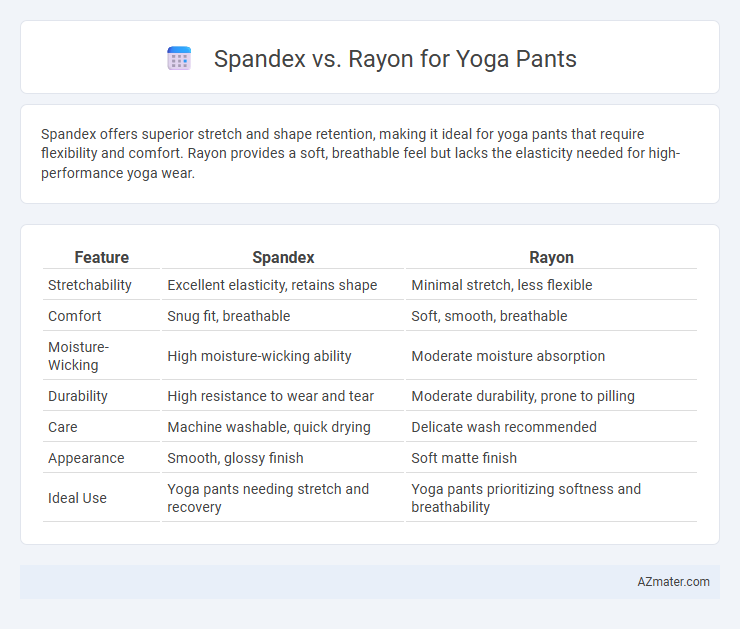Spandex offers superior stretch and shape retention, making it ideal for yoga pants that require flexibility and comfort. Rayon provides a soft, breathable feel but lacks the elasticity needed for high-performance yoga wear.
Table of Comparison
| Feature | Spandex | Rayon |
|---|---|---|
| Stretchability | Excellent elasticity, retains shape | Minimal stretch, less flexible |
| Comfort | Snug fit, breathable | Soft, smooth, breathable |
| Moisture-Wicking | High moisture-wicking ability | Moderate moisture absorption |
| Durability | High resistance to wear and tear | Moderate durability, prone to pilling |
| Care | Machine washable, quick drying | Delicate wash recommended |
| Appearance | Smooth, glossy finish | Soft matte finish |
| Ideal Use | Yoga pants needing stretch and recovery | Yoga pants prioritizing softness and breathability |
Introduction: Spandex vs Rayon for Yoga Pants
Spandex offers exceptional elasticity and recovery, making it ideal for yoga pants that require flexibility and shape retention during intense movements. Rayon, derived from natural fibers, provides breathability and a soft, smooth texture but lacks the stretch necessary for high-performance yoga wear. Choosing between spandex and rayon impacts the comfort, fit, and durability of yoga pants, influencing overall workout experience.
Fabric Composition: Understanding Spandex and Rayon
Spandex, a synthetic fiber known for its exceptional elasticity, is typically blended with other fibers to provide stretch and shape retention in yoga pants. Rayon, a semi-synthetic fiber derived from natural cellulose, offers a soft, breathable texture that enhances comfort and moisture absorption. The ideal yoga pant fabric composition often combines spandex's flexibility with rayon's breathability, ensuring both movement support and skin comfort during workouts.
Comfort and Stretch: Which Is More Flexible?
Spandex offers superior flexibility and stretch, making it ideal for yoga pants that require unrestricted movement and a snug fit. Rayon provides softness and breathability, enhancing comfort but lacks the same elastic recovery as spandex. Yoga pants made with a blend of spandex and rayon combine the best of both materials, delivering both comfort and high stretchability.
Breathability and Moisture Management
Spandex offers excellent stretch and shape retention but has limited breathability compared to rayon, which is more breathable and naturally moisture-wicking. Rayon fibers facilitate better air circulation and moisture absorption, making yoga pants with rayon blends ideal for sweat management during intense workouts. Choosing a fabric with a higher rayon content enhances comfort through superior breathability and moisture management, while spandex ensures flexibility and fit.
Durability: Longevity of Spandex vs Rayon
Spandex offers superior durability and elasticity, making it ideal for yoga pants that require frequent stretching and movement without losing shape. Rayon, while soft and breathable, tends to wear out faster and is more prone to stretching and fabric weakening over time. Choosing spandex ensures longer-lasting performance, maintaining the integrity of yoga pants through rigorous workouts and repeated washing.
Fit and Shape Retention in Yoga Pants
Spandex offers superior stretch and elasticity, ensuring yoga pants maintain a snug fit that moves with the body during dynamic poses. Rayon provides a soft, breathable feel but lacks the same level of shape retention, often resulting in sagging or bagging after extended wear. For optimal fit and lasting shape retention, a blend of spandex with rayon balances comfort and performance in yoga pants.
Care Requirements: Maintenance and Washing
Spandex yoga pants require gentle care to maintain elasticity, best washed in cold water and air-dried to prevent fabric damage. Rayon yoga pants demand delicate handling due to their sensitivity to heat; hand washing or machine washing on a gentle cycle with mild detergent is ideal, and avoiding high-heat drying preserves fabric integrity. Proper maintenance of both materials extends garment lifespan, with spandex benefiting from avoiding bleach and rayon from minimizing friction during washing.
Environmental Impact: Sustainability Comparison
Spandex production relies heavily on petrochemicals, contributing to environmental pollution and non-biodegradable waste, while rayon is derived from natural cellulose fibers but often involves chemically intensive processing that can harm ecosystems. Bamboo-based rayon variants boast better sustainability profiles due to renewable sourcing and lower chemical use, yet many rayon manufacturing practices still present significant ecological concerns. Choosing yoga pants made from recycled spandex blends or sustainably produced bamboo rayon can reduce environmental footprints by promoting resource efficiency and minimizing toxic emissions.
Price and Value for Money
Spandex yoga pants generally cost more than rayon options due to superior elasticity and durability, offering better value for active wear with sustained shape retention. Rayon pants provide a softer feel at a lower price point but tend to stretch out and lose shape quicker, making them less cost-effective over time. Investing in spandex blends ensures longer-lasting performance and better support, justifying the higher initial price for frequent yoga practitioners.
Final Verdict: Which Fabric Suits Your Yoga Needs?
Spandex offers superior stretch and durability, making it ideal for high-intensity yoga sessions requiring flexibility and support. Rayon provides a softer, breathable feel, perfect for gentle yoga practices or leisurewear with a focus on comfort and moisture absorption. Choosing between spandex and rayon depends on your yoga style and preference for either performance or softness in your yoga pants.

Infographic: Spandex vs Rayon for Yoga Pant
 azmater.com
azmater.com